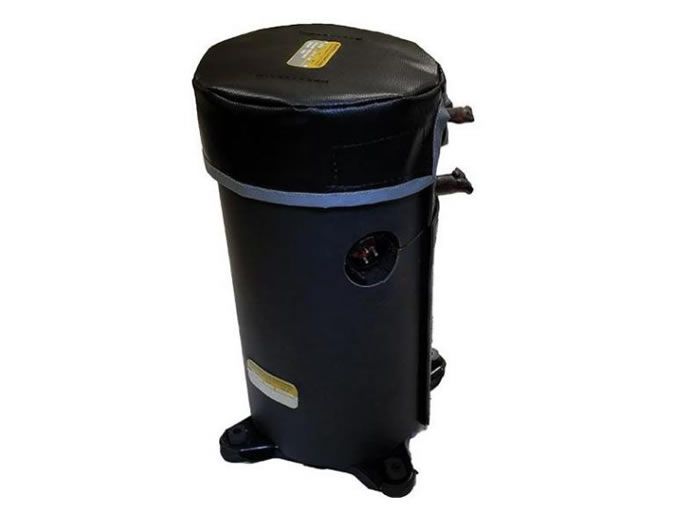HVAC COMMERCIAL/INDUSTRIAL APPLICATION SHIELD
LT250AS (LT121C-AS)
INTRODUCTION
Shannon design LT250AS Acoustic Shields are used in commercial liquid chiller settings with surface temperatures between Ambient to 250F. This cost effective acoustic insulation is ideal for small chiller applications, namely scroll compressors. This design can accommodate indoor & outdoor weather conditions as the jacketing materials are oil and water resistant. A self contained acoustic shield with integral fasteners, this acoustic design meets the mark on performance reduction while at the same time, it offers easy access for inspection, service and repair. Shannon acoustic blankets are flexible and easy to install and remove.
Common Applications and Markets
Scroll Compressors, Compressor Discharge Piping.
Service Temperature
This design is to act as a Sound Attenuation and Thermal Barrier, with a maximum service temperature of 250˚F (121˚C).
Blanket Components
The Outer Jacketing is a Non-Reinforced Mass Loaded Vinyl Barrier Sheet 1lb/sf to 2lb/sf (4.9kg/m²-9.8kg/m²). The Insulation Core consists of ¾” (2CM) thickness, EPDM Elastomeric Closed Cell Foam Insulation, with a smooth and durable surface, which acts as a sound Absorber in conjunction with the Mass Loaded Vinyl Barrier. A high performance scrim reinforced acrylic pressure sensitive adhesive (-15ºF to 280ºF max. continuous service temp.) is utilized to adhere the material to the outer jacketing. The Shannon Acoustic Shield integrates, Velcro® hook-and-loop fasteners for easy installation, removal & re-installation.

Body Wrap & Rain Shield Cap
BLANKET THICKNESS SURFACE TEMPERATURE REFERENCE
Operating Temp |
Thickness |
Surface Temp |
Thickness |
Surface Temp |
Thickness |
Surface Temp |
|---|---|---|---|---|---|---|
| 121˚ C (250˚ F) | 25 mm( 1″) | 37.9˚ C (100.2˚ F) | 40 mm( 1.5″) | 33.3˚ C (92.0˚ F) | 50 mm (2″) | 30.8˚ C (87.4˚ F) |
* The above referenced Cold Face Surface Temperatures should be used as guidelines for blanket insulation thickness design.
* The Cold Face Surface Temperature of the blanket should approach surrounding ambient temperature conditions.
* The economic thickness of the blanket should consider blanket cost, thermal performance and blanket design constraints.
* Heat loss calculations are based on a 21.1˚ C (70˚ F) ambient temperature using a flat surface condition.
THICKNESS |
SURFACE MASS |
Noise Reduction Range |
|---|---|---|
| 3/4” (1.9CM) | 1.8 lb/ft² to 2.8 lb/ ft² (8.8-13.7kg/m²) | 1.5 DBA to 6 DBA Reduction |
| 1 ½” (3.8CM) | 2.2 lb/ ft² to 3.2 lb/ ft² (10.7-15.6kg/m²) | 4 DBA to 8 DBA Reduction |
* The above referenced Acoustic Performance should be used as a guideline for blanket insulation thickness design.
* The Acoustic Performance of the blanket should be bench marked against the ambient noise condition.
* The economic thickness of the blanket should be considered in selection of a target reduction with consideration to blanket design constraints.
* Contact Shannon for guidance in selection, as the historical performance of each application varies significantly.
